On June 30, Long on Value became Ten Strike’s first G1 winner as he stormed down the stretch to take the $250,000 Highlander Stakes at Woodbine.
Purchased from the 2017 Keeneland November sale for $100,000, Long on Value is now undefeated in his two starts for new owners Ten Strike Racing, Madaket Stables and Steve Laymon.
This victory earned him a “Win and You’re In” berth to the Breeders’ Cup Turf Sprint at Churchill Downs this November. The Turf Sprint will be run over the same course as the Mighty Beau Stakes which Long on Value proved victorious in earlier this summer.
The first half of 2018 has proved extremely successful for Ten Strike Racing as the group has seen both their first Graded Stakes win (Ezmosh- G3 Arlington Classic) and Grade 1 win in only the second year of operations.
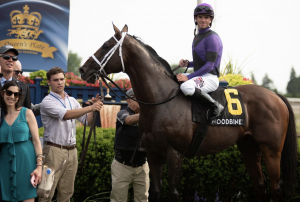
In his first start for new owners Ten Strike Racing, Steve Laymon and Madaket Stables (Sol Kumin), Long on Value flew from last to first in the stretch to win the $75,000 Mighty Beau Stakes under the lights at Churchill Downs.
Ten Strike acquired Long on Value from the 2017 Keeneland November Racehorse Sale after he was purchased by Brad Cox for $100,000.
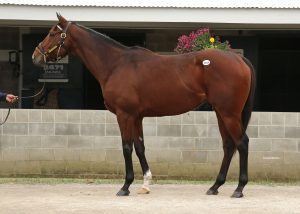
For his next start, Long on Value will be pointed to the G1 $175,000 Highlander Stakes going 6 furlongs at Woodbine on June 30th, which is also a Breeders’ Cup ‘Win and You’re In’ qualifier for the Turf Sprint.
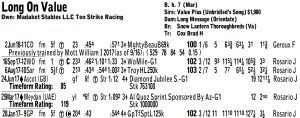
Originally written by Dick Jerardi of the Pennsylvania Thoroughbred Horsemen’s Association.
May 31, 2018
Marshall Gramm is an economics professor at Rhodes College in Memphis, Tenn., its urban campus renowned for its beauty, its 2,025 students from 46 states and 43 countries celebrated for their community service. Gramm is also an owner of 40 horses in training spread around several American race tracks. There is, however, one track that stands out for Gramm – Parx Racing.
“I consider Parx my home base,’’ Gramm said. “I’m always looking to bring a good horse to Parx whether I’m buying it at a sale, whether I’m buying it privately or whether I’m claiming it.’’
In fact, Gramm’s Ten Strike Racing was the leading owner at Parx in 2016 and 2017. He has 12 to 18 horses in training at Parx at any one time. He pays a $75 day rate (per horse per day). The trainer and jockey each get 10 percent of winning purses. The vet gets paid. Gramm pays the horse van company, which happens to be Brook Ledge, with a Pennsylvania hub based in Oley, near Reading. He figures he has a van bill approaching six figures every year.
“I love buying horses elsewhere and bringing them to Pennsylvania to race,’’ Gramm said. He claimed 14 horses at the 2018 Oaklawn Park meet. Half of them ended up at Parx.
“Parx has a great purse structure,’’ Gramm said. “Parx has a wonderful condition book. I really love how they do their condition book, better than any track in the country, just in terms of how it’s methodically set up. It’s why I enjoy racing there. It’s a great locale to base horses.’’
So the economics professor, son of former Texas United States Senator Phil Gramm, is a serious economic driver in the Commonwealth.
“I’m a breeder,’’ Gramm said, “I’ve got PA-Breds. I have a significant number of horses that all come from out-of-state. So if anyone knows anything about owning horses, almost all my money just plows right back into Parx. Look, I made some money in 2016, lost a little bit in 2017 and look good in 2018. It’s hardly like you can take that purse money and imagine that all comes in my pocket. It all goes back to (trainer Carlos Guerrero), his staff, building up his stable. A small fraction, if I make a profit at all, comes back in my direction.’’
Gramm has two mares at Pin Oak Lane Farm in New Freedom, York County. One of them was bred to Pennsylvania sire Jump Start.
“I don’t come up to Pennsylvania often enough or Parx often enough, but I think of it as my home track,’’ Gramm said. “I bet Parx on a daily basis. The only difference between me and some of your owners up there is that I live in Memphis, Tennessee. I don’t think that changes any part of the equation of where my money goes. I guess if I have a good day, I might go a restaurant in Memphis versus a restaurant in (Bensalem). But that’s really about it.’’
Gramm pays taxes in Pennsylvania. His trainer’s staff, including grooms, hot walkers and exercise riders, is all employed in Pennsylvania.
Gramm owns most of the stable’s claiming horses himself. He also puts partnerships together for horses he buys as yearlings and 2-year-olds with the main objective being Oaklawn Park for partners that live in Arkansas. He has a few horses at Monmouth Park, Laurel Park and Golden Gate Fields.
“We file (taxes) in all the different states we race,’’ Gramm said. “We ran at 30 different tracks last year and we won races at 16 different tracks. We won 69 races.’’
In 2017, he had 10 different trainers, with the attendant accounting and bookkeeping issues.
“I used to do that on my own, but I basically outsourced that to my accountant,’’ Gramm said. “It was too much.’’
Parx, however, is always his favorite track.
“It’s the place that I want to race of all the tracks I sort of look at,’’ Gramm said, “It fits my ownership profile. I don’t have enough money to compete in New York.’’
It’s laughable when somebody suggests the purse money at Parx is going to sheikhs. Gramm would know.
“I feel like a lot of the owners at Parx are a lot like me,’’ Gramm said. “A lot of them are small businessmen. I don’t think of Parx owners as a series of outsiders. I’m an anomaly, but I feel like I’m not a poacher. The only way I’m an anomaly is that I don’t live in Pennsylvania.’’
He contributes so much to the commonwealth’s economy every year it is almost as if he lives here.
“I pay taxes in Pennsylvania,’’ Gramm said. “I have a big business. I did over $785,000 in purses. Almost all of that money gets churned right back into my business, buying more horses, breeding horses, helping to pay for my operation.’’
And, in his real job, he is also helping grow the overall business. He taught an “Economics of Race Track Wagering Markets’’ class in the spring of 2017. He had 35 students and plans to teach the class every other spring semester.
“All those students e-mailed me their Derby picks,’’ Gramm said. “When I teach my other classes, it’s hard not to work in horse racing-related examples.’’
So Marshall Gramm has a serious racing stable. He teaches about the game. And he is the leading owner at Parx.
On Saturday, Ezmosh took the G3 Arlington Classic to become Ten Strike’s first Graded Stakes winner in just 2 years of the syndicate’s existence. A recent private purchase for the group, he stalked the pace and showed a quick turn of foot in the stretch to draw away from the field.
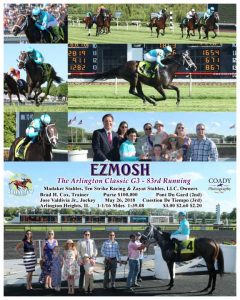
Both Ten Strike and Madaket Stables (Sol Kumin) teamed up to partner with original owners Zayat Stables on the 3 year old Brad Cox-trainee who is now 2 for 2 since switching surfaces to the turf. Ezmosh will point to the G3 American Derby on July 7th at Arlington for his next start.

Marshall Gramm was recently featured in the Blood Horse following Black Stetson’s win in the Bridgetown Stakes. Click below to read the full article:
Black Stetson scored in the first ever running of the Bridgetown Stakes at Aqueduct going wire-to-wire 6 furlongs on the Turf at 18-1 for trainer Juan Carlos Guerrero.
Privately purchased by Ten Strike after a last place finish in a Maiden $75k at Keeneland, Black Stetson has truly rounded into form under Juan Carlos Guerrero. He broke his maiden in his second start for Ten Strike, ran 2nd in an Alw-1X and on April 14th, won the Bridgetown Stakes at Aqueduct in a gritty fashion. He hasn’t finished out of the top two in his three starts of 2018 earning just shy of $100,000.

After this tenacious victory against stiff New York company, Black Stetson looks to be primed for a Stakes filled Spring/Summer campaign.
Dot Matrix, a homebred for Ten Strike Racing, turned in a major effort to run 2nd by a nose to G2 winner Arklow in an Allowance on February 24th at the Fair Grounds. Traveling two-wide the entirety of the race, he was just caught by a late running Arklow who is a very talented turf horse geared for a big 2018.
Since transferring barns to Brad Cox, Dot Matrix has now strung together back-to-back impressive performances (a first and second) at the Fair Grounds.
Dot Matrix is out of Aunt Dot Dot who Ten Strike co-founder Marshall Gramm claimed in 2008. It was the first horse he ever claimed and he still owns her.
Not only did Dot Matrix earn a career best 90 Beyer, his TimeFormUS rating of 116 came back higher than Arklow’s in the same race (115).
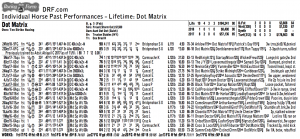
A New York bred that has earned $184,241, he will head back to New York for his next start. Dot Matrix gave the Ten Strike Partnership a massive thrill this past summer at Saratoga, and is trending toward more thrills to come!
Since first entering the barn of Brad Cox in June of 2017, Cheponera has displayed flashes of serious talent. On Friday, she put it all together storming home to a 3 length Allowance score.
Purchased by stable manager and bloodstock agent Liz Crow on behalf of Ten Strike Racing from the 2017 OBS June Sale for $27,000, she made two starts before breaking her maiden in her third start on Thanksgiving Day at Churchill Downs.
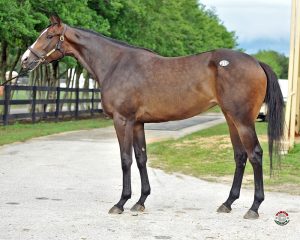
On Friday, she made her first start of 2018, winning a $76,000 Allowance race at Oaklawn Park. This was her first test around two-turns and she handled it like a complete professional. Jockey Fernando De La Cruz settled her on the rail as they stalked the pace setting First Alternate. As they entered the stretch, Cheponera briefly engaged First Alternate before putting her and the rest of the field away (Replay here).

Cheponera, who is now undefeated since adding blinkers, earned a 78 Beyer and a 12 ½ Ragozin and winning her last two starts by a combined 7 ½ lengths. This win and subsequent numbers places her, and Ten Strike Racing, in the middle of a Kentucky Oaks bid. She will next target the G3 Honeybee going 1 1/16 miles at Oaklawn.
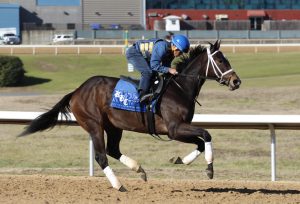
Below is an excerpt from an article written in the DRF on Cheponera and her performance:
“Cheponera, also ridden by De La Cruz, stalked the pace, overtook the leaders, and shuttled home for a 3 1/4 length win in the 1 1/16-mile allowance for 3-year-old fillies. It was her first start at two turns, and her second straight win behind a $30,000 maiden-claiming race at a one-turn mile Nov. 23 at Churchill Downs.
“She stepped up,” Cox said. “The first couple of races she just didn’t perform quite as well as we thought she would. She’s gotten better with distance. Her last two races have been really nice.”
Cheponera, a daughter of Flat Out who races for Ten Strike Racing, earned a Beyer Figure of 78 and will be pointed to the Honeybee, a 1 1/16-mile race March 10 at Oaklawn that serves as the final stepping-stone to the Grade 3, $400,000 Fantasy on April 13.” Full article here.
Congratulations to all of our partners on a fantastic win! Lots to look forward to and she has certainly become a favorite of the group! Pictured below with Sophia (daughter of Ten Strike partner Gary Garlington)
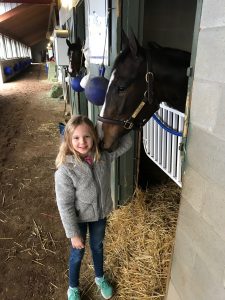
Blood-Horse Article:
Ten Strike Racing’s Zanotti shipped outside Parx Racing for the first time since 2016 and found the going at sloppy Aqueduct Racetrack to his liking as the Gio Ponti gelding rallied on the outside to post a neck victory in the $125,000 Queens County Stakes at 38-1 odds.
Settled in mid-pack by jockey Jorge Vargas Jr., Zanotti stalked comfortably in fifth as favored Alex the Terror led the field of nine through fractions of :24.33 for the opening quarter-mile with the half-mile in :48.47. At the quarter pole, Alex the Terror remained in front as Zanotti angled four-wide into the upper stretch and began passing foes. Zanotti collared Alex the Terror at the sixteenth pole and they engaged in a battle to the wire, with Zanotti securing the win with the last bob.
The final time was 1:51.64 for the 1 1/8 miles over the sloppy, sealed track.
Zanotti returned $78.50, $25.20, and $11.60 across the board.
Trained by Juan Carlos Guerrero, the 4-year-old picked up his first black-type win Saturday and improved his record to 7-3-2 in 18 starts, with earnings of $251,904. The Queens County was the first start for the winner since he took an optional-claiming allowance at Parx July 25.
“First of all I have to give a lot of credit to Carlos Guerrero,” Vargas said. “He brought this horse with his ‘A’ game. He hasn’t run since July, that was my main concern, but he was training so good. When I asked him to take a shot, he was all out for me. I thought he was going to be a little sharper (out of the gate) than he was, so I just let him flow out there and he just put me in the right spot. Good trip. When I angled out he just took off.
“I have always told Carlos that he is a nice horse. He can run all day. You work him five-eighths, he goes in a minute and then he wants to keep galloping out to the quarter pole without even blowing.”
Zanotti was bred by Kilboy Estate and Castleton Lyons, the farm near Lexington where the winner’s sire, Gio Ponti, stands for a 2018 fee of $5,000.
Co-Founder of Ten Strike Racing Marshall Gramm, spoke at the Global Symposium on Racing in Arizona on December 4th.


Article in the Daily Racing Form…
TUCSON, Ariz. – A succession of racing analysts appearing on a Tuesday panel at the University of Arizona Global Symposium on Racing urged racetracks in the U.S. to lower takeout rates for single-race bets such as win and exacta wagers in order to reverse protracted declines in betting on horse racing.
The panelists, appearing on the opening morning of the two-day Symposium, included an economics professor specializing in wagering markets, a former top official at the New York Racing Association and the Hong Kong Jockey Club, and the head of a rebate shop. All contended that both racetracks and their customers would benefit from the reductions, while cautioning that any proposal to reduce takeout rates would need to be endorsed long-term by the largest racetracks in the country to bear fruit.
“It has to start with the industry leaders,” said Bill Nader, a former chief operating officer of the New York Racing Association who was also the executive director of racing at the Hong Kong Jockey Club for eight years, ending in 2016. “And they have to make a big leap. This will not work in isolation.”
In a larger context, the comments from the panelists could be viewed as an unusually sharp rebuke to Keeneland, the central Kentucky racetrack that drew widespread criticism from the horseplaying community earlier this year when it raised the takeout rates for its bets for the fall meet. All three panelists cited the Keeneland decision while making their remarks, with several taking particular issue with Keeneland’s justification of needing more revenue from wagering to boost purses.
“There may be short-term gains, but there are long-term losses,” said Marshall Gramm, a professor of economics at Rhodes College who is well known in the horseplaying community and who described himself in his opening remarks as “a horseplayer first, and an economist second.”
Citing statistical models he built to examine the impact of takeout rates on the amount racetracks retain from wagering, Gramm said that reductions in takeout long-term would have no statistical impact on the amount of money retained by tracks because of the impact of churn. Under the low-takeout model, because players would bet more of their winnings back into the pools, racetracks would retain the same amount of money on betting over the longer period of time, Gramm said.
To optimize the impacts of churn, Gramm and the other two advocates for lower takeout rates said that racetracks needed to prioritize single-race bets such as win, place, show, exacta, and trifecta for the takeout reductions. They also claimed that lowering or maintaining low takeout rates for multi-race wagers like the pick 4 and pick 5, along with jackpot-style bets that only pay out if there is a single winner, is counter-productive, contradicting a handful of recent decisions by racetracks. (Keeneland raised all of its takeout rates with the exception of the pick 5, which it lowered.)
“I don’t personally understand why a 15 percent takeout rate is needed on a pick 5 when it only comes out once and that money is tied up for five races,” Nader said.
Both Nader and Gramm pointed out that bettors are more likely to cash a winning bet on single-race wagers, and that they are also more likely to bet the winnings from those wagers back into the pool. As an ancillary benefit, Nader and Gramm said, racetracks should also push new horseplayers to bet on the simpler low-takeout bets in order to maximize the possibility that those players will have a rewarding experience when playing.
To read more go to DRF.com or click here



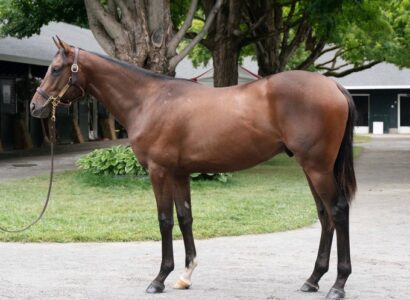
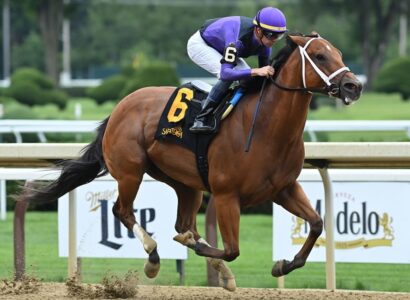
 Ten Strike Racing
Ten Strike Racing